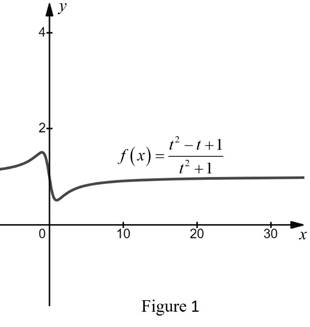
Concept explainers
(a)
To find: the limit of f when t approaches in infinity.
(a)
Answer to Problem 39E
The limit of the function approaches 1 when t approaches infinity.
Explanation of Solution
Given information:
The function
The level of oxygen is
Calculation:
It is given that the level of oxygen is
The limit of the function as x approaches infinity.
If t approaches infinity, then
Therefore, the limit of the function approaches 1 when t approaches infinity.
(b)
To sketch: the graphs of the function f and verify the result of part (a).
(b)
Explanation of Solution
Graph:
The graph of the function f as shown in Figure 1.

Interpretation:
From Figure 1, it is observed that the value of the function f approaches 1 whenever x is larger and large.
That is, the limit of the function f is 1 as x approaches infinity.
(c)
To explain: the meaning of the limit in context of the problem.
(c)
Answer to Problem 39E
The level of oxygens gets normal level over the long period of time.
Explanation of Solution
Interpretation:
In the context of the problem, the value of the function
Here, the function
It is given in the problem that
The term
Therefore, the level of oxygens gets normal level over the long period of time.
Chapter 12 Solutions
EBK PRECALCULUS W/LIMITS
- 2. Suppose that U(x, y, z) = x² + y²+ z² represents the temperature of a 3-dimensional solid object at any point (x, y, z). Then F(x, y, z) = -KVU (x, y, z) represents the heat flow at (x, y, z) where K > 0 is called the conductivity constant and the negative sign indicates that the heat moves from higher temperature region into lower temperature region. Answer the following questions. (A) [90%] Compute the inward heat flux (i.e., the inward flux of F) across the surface z = 1 - x² - y². (B) [10%] Use the differential operator(s) to determine if the heat flow is rotational or irrotational.arrow_forwardCould you show why the answer is B Using polar coordinates and the area formulaarrow_forward1. The parametric equations x = u, y = u cos v, z = usin v, with Ou≤ 2, 0 ≤ v ≤ 2π represent the cone that is obtained by revolving (about x-axis) the line y = x (for 0 ≤ x ≤2) in the xy-plane. Answer the following questions. (A) [50%] Sketch the cone and compute its surface area, which is given by dS = [ | Ər Or ди მა × du dv with S being the cone surface and D being the projection of S on the uv-plane. (B) [50%] Suppose that the density of the thin cone is σ(x, y, z) = 0.25x gr/cm². Compute the total mass of the cone.arrow_forward
 Calculus: Early TranscendentalsCalculusISBN:9781285741550Author:James StewartPublisher:Cengage Learning
Calculus: Early TranscendentalsCalculusISBN:9781285741550Author:James StewartPublisher:Cengage Learning Thomas' Calculus (14th Edition)CalculusISBN:9780134438986Author:Joel R. Hass, Christopher E. Heil, Maurice D. WeirPublisher:PEARSON
Thomas' Calculus (14th Edition)CalculusISBN:9780134438986Author:Joel R. Hass, Christopher E. Heil, Maurice D. WeirPublisher:PEARSON Calculus: Early Transcendentals (3rd Edition)CalculusISBN:9780134763644Author:William L. Briggs, Lyle Cochran, Bernard Gillett, Eric SchulzPublisher:PEARSON
Calculus: Early Transcendentals (3rd Edition)CalculusISBN:9780134763644Author:William L. Briggs, Lyle Cochran, Bernard Gillett, Eric SchulzPublisher:PEARSON Calculus: Early TranscendentalsCalculusISBN:9781319050740Author:Jon Rogawski, Colin Adams, Robert FranzosaPublisher:W. H. Freeman
Calculus: Early TranscendentalsCalculusISBN:9781319050740Author:Jon Rogawski, Colin Adams, Robert FranzosaPublisher:W. H. Freeman
 Calculus: Early Transcendental FunctionsCalculusISBN:9781337552516Author:Ron Larson, Bruce H. EdwardsPublisher:Cengage Learning
Calculus: Early Transcendental FunctionsCalculusISBN:9781337552516Author:Ron Larson, Bruce H. EdwardsPublisher:Cengage Learning





